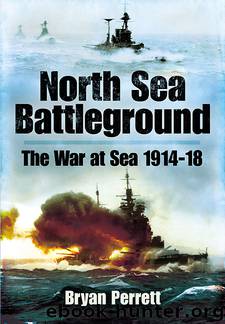North Sea Battleground: The War at Sea 1914-1918 by Bryan Perrett

Author:Bryan Perrett [Perrett, Bryan]
Language: eng
Format: epub
Tags: WWI, World War I, North Sea
ISBN: 9781848844506
Google: EDGyuAAACAAJ
Amazon: 1848844506
Publisher: Pen & Sword
Published: 2011-05-15T04:00:00+00:00
CHAPTER 9
Strafing the Island (1)
Count Ferdinand von Zeppelin was born in 1838. He served in the Royal Wurttemberg Army, in which he fought during the Franco-German War of 1870. In 1890 he left the Army feeling, as did many South German noblemen, that Prussia had far too much influence in the recently created German Empire. He then devoted himself to the development of the rigid dirigible airship which has born his name ever since. In fact, his organisation, the Luftshiffbau Zeppelin was not alone in manufacturing this type of airship, the Luftshiffbau Schutte-Lanz being a competitor during the early years, although by custom ever since every rigid airship has become known as a Zeppelin, just as vacuum cleaners are known as Hoovers and raincoats as Macintoshes.
Zeppelin chose hydrogen as the lifting agent for his airships, despite the terrible danger of fire, the outbreak of which was almost always fatal to the ships. The hydrogen was contained within huge gasbags along the interior of the hull, with provision for venting and water ballast tanks used to maintain stability while ascending or descending. These were contained in a long, sausage-shaped hull based on a complex internal girder construction surrounded by a flexible skin. Control and communications gondolas were suspended below, as were the ship’s engines, the number of which varied according to type.
At first, Zeppelin’s organisation was not a financial success and it was not until 1911 that his airline, the Deutsche Luftschiffahrts AG began to show that large numbers of passengers could be carried at a profit. This aroused the interest of the Imperial German Army and Navy. The obvious advantages were that the Zeppelin had a very long in-flight endurance which made it capable of longrange reconnaissance and, of course, it could also be armed with bombs for dropping on specific targets. Of the disadvantages, fire has already been mentioned. In addition, the girder construction was so flimsy that clumsy handling in a shed or high winds on take-off or landing could wreck a ship. Even more serious was the fact that Zeppelins were extremely difficult to navigate. Even modest winds were capable of pushing the huge, lighter-than-air hulls many miles off course, while cloud cover could make it impossible to obtain a fix on the ground below. Later, a small car containing one or two observers and a telephone could be lowered by electric winch through the cloud and provide a view of the ground below, but the idea was not a success.
During World War One, Zeppelins served in every German theatre of war save East Africa, and even there one tried to get through, albeit unsuccessfully, by overflying Egypt and the Sudan. The Army preferred to use them for deep reconnaissance but would occasionally mount a bombing mission. The Navy used them as scouts for the operations of the High Seas Fleet but also carried out raids well inland into England, proving that nowhere was safe from the attentions of the Imperial Navy. Naval Zeppelin bases were established
Download
This site does not store any files on its server. We only index and link to content provided by other sites. Please contact the content providers to delete copyright contents if any and email us, we'll remove relevant links or contents immediately.
| Africa | Americas |
| Arctic & Antarctica | Asia |
| Australia & Oceania | Europe |
| Middle East | Russia |
| United States | World |
| Ancient Civilizations | Military |
| Historical Study & Educational Resources |
Room 212 by Kate Stewart(4735)
The Crown by Robert Lacey(4572)
Endurance: Shackleton's Incredible Voyage by Alfred Lansing(4503)
The Iron Duke by The Iron Duke(4120)
The Rape of Nanking by Iris Chang(4022)
Killing England by Bill O'Reilly(3897)
Joan of Arc by Mary Gordon(3782)
Say Nothing by Patrick Radden Keefe(3725)
I'll Give You the Sun by Jandy Nelson(3272)
Shadow of Night by Deborah Harkness(3173)
Hitler's Monsters by Eric Kurlander(3164)
Mary, Queen of Scots, and the Murder of Lord Darnley by Alison Weir(3063)
Blood and Sand by Alex Von Tunzelmann(3055)
Darkest Hour by Anthony McCarten(3018)
Margaret Thatcher: The Autobiography by Thatcher Margaret(2971)
Eleanor & Park by Rainbow Rowell(2943)
Red Famine: Stalin's War on Ukraine by Anne Applebaum(2816)
Book of Life by Deborah Harkness(2717)
The One Memory of Flora Banks by Emily Barr(2684)
